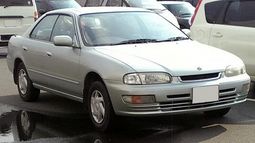The History Of Nissan Presea

The Nissan Presea was a compact car, produced for the Asian market from 1990 to 2000.
The original R10 Presea was based on the B13 Nissan Sentra/ Sunny platform. It shared many attributes with its sibling model, however, body panels and interior were done to a much higher specification. Interior fabrics matched those on the Bluebird , with standard features including automatic headlights, lighted keyslot, rear-illuminated instrument cluster, integrated sound-system, automatic climate control, digital temperature control, adjustable shoulder height seat-belts, 4-way adjustments, lumbar support for the driver's seat, windscreen wipers with adjustable intermittent timings, remotely-controlled wing mirrors that folded close and most importantly, frameless windows that mimicked the NX Coupe and Silvia. In fact, so feature-full and advanced was the car that many units had 4-disc brakes with ABS and a rear windscreen wiper.
The A-pillar was slightly thinner than most compact cars, and the B-Pillar was practically non-existent from the outside, and on the inside, it was just wide enough to accommodate the seat-belt assembly. The C-pillar created a wrap-around rear windscreen. All these design features allowed for a more than 300-degree of vision for the driver, much like that of a fighter pilot. The rounded exterior left no visible straight edge on the car, and the grill-less front end gave the car a very sleek and futuristic look.
The R11 Presea launched in 1995 was slightly lengthened. In some countries including Japan, the venerable SR18DE with 125 hp replaced the 110 hp SR18D(i) engine, alongside with GA15DE and SR20DE engines. It still had the same drive-train as Nissan Sunny B14 (1994-1998) and the same frame-less door windows as the R10 Nissan Presea, although it was a little longer (4425 mm + 2525 mm wheelbase) wider (1695 mm) and taller (1325 mm).
In Singapore, Thailand and New Zealand, the R11 Presea came predominantly with the ancient 1.6L GA16DE. With essentially every curve and panel being unchanged, and only a fresher looking headlights and rear lamp cluster the car still had the same old macpherson struts suspension up front and rear multi link geometry. Market demand for such a car fell rapidly, which was similar to the disappearance of the 4-door Honda Integra. The demand for luxury compacts had fizzled out.
Dimensions
The Presea was an in-betweener - halfway between the Sunny/ Sentra/ Pulsar and Bluebird/ Primera ranges.
Compared to most compact cars of that time, the Nissan Presea was quite long. The R10 stood at 4420 mm, 15 centimetres longer than the Sentra. It was also pretty low for sedan at 1320 mm; with passengers often feeling the need to stoop to get into the car. At 1690 mm wide, it was as wide as it needed to be for 2 adults (and possibly a child) in the rear seats. The slightly longer wheelbase (compared to the Sunny) at 2500 mm was class leading for that era of compact cars. All these dimensions added up to a comfortable (albeit low) car with decent comfort and presence. The boot space was more than adequete, at over 300L in capacity. Due to the way the backseats lean back (which in turn gave the rear passengers a lot more comfort) objects over 1000 mm in length and 1200 mm in width could fit. The boot height of over 400 mm also allowed for a competent handling of most purchases during shopping sprees. However the narrow aperture height limited its usability.
Handling Prowess
For more decent handling, it had Macpherson struts up front with multi-link rear suspension (with parallel arms). This independent setup combined with the longer wheelbase gave good comfort on the highway, and a pretty good grip for aggressive cornering. For many Preseas, the car was endowed with a ventilated front disc brakes with a single large piston. The rear brakes were either a solid disc brake or a semi-trailing drum brakes with self-adjusting shoes.
Engine Sizes
In Japan, most Preseas came with either a 1498cc GA15DS, 1798cc SR18Di engine and the venerable 1998cc SR20DE. For the rest of the world, a more common 1598cc GA16DE engines was available, providing sufficient grunt and fuel economy with its VTC (Variable Valve Timing) and DOHC design. As its engine bay was slightly longer than a B13 Sentra, an SR20DET engine could be shoehorned into it without much trouble. Standard Nissan mounting points allowed for the easy swapping of clutches and gearboxes between models in this range of cars. With the ample under-bonnet capacity, larger turbos and intercoolers could be fitted provided the owner did not mind slight modifications to the engine bay.
From Wikipedia, the free encyclopedia
More About Nissan Presea

|